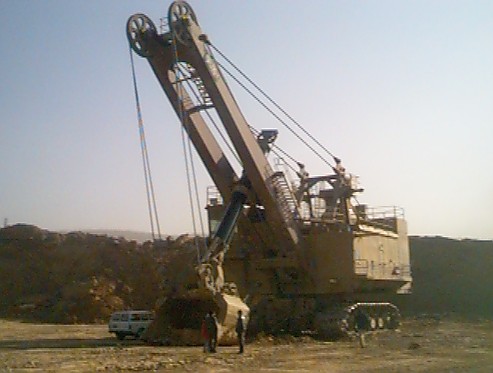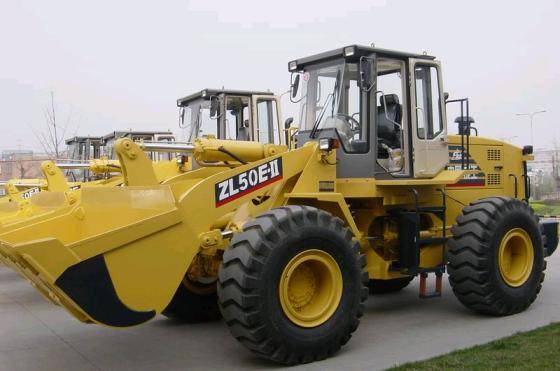New Large Capacity Torque Converter
Similar to WA480-6, WA470-6 has a newly designed Large Capacity Torque Converter that provides excellent tractive effort, improved acceleration and improved hill climbing ability. The machine has greater productivity in V-cycle applications because of the increased tractive effort. The improved hill climbing ability allows WA470-6 to up-shift gears faster due to the improved acceleration, achieve higher gear ranges and maintain higher ground speeds when working in load-and-carry or hopper feeding applications. In either application, production is increased and fuel consumption maximized resulting in improved fuel efficiency (tons/gal).
Increased fuel efficiency and maximum productivity
WA470-6 is powered by a Komatsu SAA6D125E-5 diesel engine with an Electronic Heavy Duty Common Rail fuel injection system that provides fast throttle response while optimizing fuel combustion. The engine is EPA Tier 3 emission certified without sacrificing power or machine productivity.
Fuel consumption is greatly reduced because of the high-torque engine and the large capacity torque converter, as well as the CLSS (Closed-Center Load Sensing System). With two selectable operating modes that adjust easily, the engine effortlessly adapts to different working conditions. The E mode provides maximum fuel efficiency for general loading and the P mode has a maximum power output for hard digging operation and hill climbing. For load-and-carry or hill-climb operations, the torque converter with optional lock-up transmission provides increased production efficiency, reduced cycle times and optimum fuel savings. An Eco Indicator informs the operator when the machine is maximizing fuel efficiency.
Easy maintenance for a reliable machine
Using strict quality control, Komatsu manufactures all machine parts with an integrated production system to create a reliable machine with very low maintenance costs and easy service access. Equipped with the exclusive Komatsu EMMS (Equipment Management Monitoring System), the operator stays informed of all machine functions on the easy-to-read monitor. An automatic reversible hydraulic radiator fan allows the operator to quickly clean out the cooling system at preset intervals or with the flip of a switch.
New large cab provides excellent operator environment
The wide and spacious cab of WA470-6 can reduce operator fatigue and increase productivity. The wide pillar-less flat glass affords excellent front visibility, and the wiper arm covers a large area for excellent visibility on rainy days. The cab's low-noise design of 72 dB (A) creates a comfortable working environment.
With its built-in ROPS/FOPS structure to protect the operator, the new roomy cab is mounted with Komatsu's unique viscous mounts to keep noise at a minimum and provide a low-vibration, clean operating environment. The layout of the cab has also been improved for easy access to levers, and the air conditioner has been relocated to the front of the cab to increase seat reclining and backward slide adjustment.
Easy Operation
With new Pressure Proportional Control (PPC) control levers, the operator can easily operate the work equipment with fingertip controls, reducing fatigue and improving fine work equipment control and productivity. The work equipment lever console can be adjusted, as can the large arm rest to provide the operator with a variety of comfortable operating positions.
Source : cmec-hb.com
Similar to WA480-6, WA470-6 has a newly designed Large Capacity Torque Converter that provides excellent tractive effort, improved acceleration and improved hill climbing ability. The machine has greater productivity in V-cycle applications because of the increased tractive effort. The improved hill climbing ability allows WA470-6 to up-shift gears faster due to the improved acceleration, achieve higher gear ranges and maintain higher ground speeds when working in load-and-carry or hopper feeding applications. In either application, production is increased and fuel consumption maximized resulting in improved fuel efficiency (tons/gal).
Increased fuel efficiency and maximum productivity
WA470-6 is powered by a Komatsu SAA6D125E-5 diesel engine with an Electronic Heavy Duty Common Rail fuel injection system that provides fast throttle response while optimizing fuel combustion. The engine is EPA Tier 3 emission certified without sacrificing power or machine productivity.
Fuel consumption is greatly reduced because of the high-torque engine and the large capacity torque converter, as well as the CLSS (Closed-Center Load Sensing System). With two selectable operating modes that adjust easily, the engine effortlessly adapts to different working conditions. The E mode provides maximum fuel efficiency for general loading and the P mode has a maximum power output for hard digging operation and hill climbing. For load-and-carry or hill-climb operations, the torque converter with optional lock-up transmission provides increased production efficiency, reduced cycle times and optimum fuel savings. An Eco Indicator informs the operator when the machine is maximizing fuel efficiency.
Easy maintenance for a reliable machine
Using strict quality control, Komatsu manufactures all machine parts with an integrated production system to create a reliable machine with very low maintenance costs and easy service access. Equipped with the exclusive Komatsu EMMS (Equipment Management Monitoring System), the operator stays informed of all machine functions on the easy-to-read monitor. An automatic reversible hydraulic radiator fan allows the operator to quickly clean out the cooling system at preset intervals or with the flip of a switch.
New large cab provides excellent operator environment
The wide and spacious cab of WA470-6 can reduce operator fatigue and increase productivity. The wide pillar-less flat glass affords excellent front visibility, and the wiper arm covers a large area for excellent visibility on rainy days. The cab's low-noise design of 72 dB (A) creates a comfortable working environment.
With its built-in ROPS/FOPS structure to protect the operator, the new roomy cab is mounted with Komatsu's unique viscous mounts to keep noise at a minimum and provide a low-vibration, clean operating environment. The layout of the cab has also been improved for easy access to levers, and the air conditioner has been relocated to the front of the cab to increase seat reclining and backward slide adjustment.
Easy Operation
With new Pressure Proportional Control (PPC) control levers, the operator can easily operate the work equipment with fingertip controls, reducing fatigue and improving fine work equipment control and productivity. The work equipment lever console can be adjusted, as can the large arm rest to provide the operator with a variety of comfortable operating positions.
Source : cmec-hb.com



















































